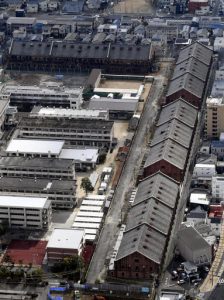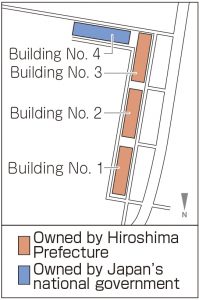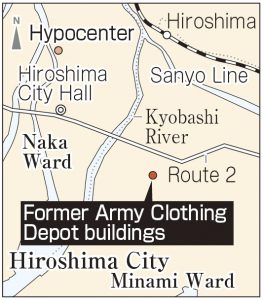Hiroshima Prefecture to start preservation work on three A-bombed former Army Clothing Depot buildings as early as next fiscal year
May 20, 2021
by Yo Kono, Staff Writer
On May 19, the Hiroshima Prefecture government formally announced a policy of seismic reinforcement on three A-bombed buildings of the former Army Clothing Depot, among the largest A-bombed structures, which are located in Hiroshima City’s Minami Ward. The prefecture has virtually reversed its original plan presented in December 2019 of dismantling two of the buildings and preserving the other’s exterior, and by so doing has taken a first step toward preservation of all three buildings. The work is expected to kick off as early as fiscal 2022, with potential uses of the buildings to be explored in the future.
Because the former Army Clothing Depot buildings have provoked heated debate in recent years regarding whether to preserve or tear down the buildings, the new policy announced this time represents a major turning point in the direction of preserving the A-bombed buildings, also called “silent witnesses” to that time, for the sake of future generations. Iwao Nakanishi, 91, an A-bomb survivor living in the city of Kure, Hiroshima Prefecture, and the chair of a citizens group calling for preservation of the former Army Clothing Depot buildings, said with anticipation, “I interpret this to mean that the prefectural government will preserve the buildings. If true, the souls of the many A-bomb victims who lost their precious lives at that place will be pleased, at the least.” Mr. Nakanishi experienced the atomic bombing in front of the depot’s building No. 1.
The new policy was explained by a prefectural official in charge of a general affairs committee at the prefectural assembly held that same day. The official said, “We want to identify the budget amount required for the implementation plans.”
Of the four patterns of building use put together by the prefecture in December of last year based on the extent of utilization of the buildings and whether or not seismic reinforcement work is performed, the new policy adopts a pattern that opens the buildings for tours of the building interiors, which would require an estimated 580 million yen per building as construction costs. The proposed pattern allows unlimited visitors on the first floor and around 50 visitors on the second and third floors for participation in tours, based on seismic reinforcement work with iron frames situated on the inside of the buildings. As the buildings can be also used as meeting rooms or a museum by implementing additional reinforcement work, the proposal is assumed to have no impact on other possible future uses of the buildings.
According to several sources, the prefectural government aims to include the planning costs to implement the seismic reinforcement work for the buildings in the general account’s supplemental budget proposal in fiscal 2021, which will be submitted at the plenary session of the prefectural assembly, scheduled to begin on June 25. If the proposal is approved by the assembly, it is estimated as of now that the construction time-period would be around one-and-a-half to two years for implementation planning work and up to two additional years per building for implementation of the seismic reinforcement work itself.
At the same time, the prefectural government will establish a review group of experts to conduct surveys considered necessary for the buildings to receive designation as nationally important cultural properties. With regard to the prefecture’s policy of conducting seismic reinforcement work based on the idea of using the buildings for interior tours, Japan’s Cultural Affairs Agency has provided its opinion that the idea is generally appropriate. The prefecture will call on the Chugoku Finance Bureau, which is in possession of the other of the four remaining Army Clothing Depot buildings, to cooperate toward receiving the designation by the national agency.
After the prefecture made the official announcement outlining its initial idea of dismantling two buildings and preserving the other’s exterior, the government had postponed the start of demolition, originally scheduled to take place sometime in fiscal 2020, due to negative feedback from A-bomb survivor groups and others. Later, experts pointed out that the buildings have enough value to be designated as nationally important cultural properties, with Hiroshima prefectural governor Hidehiko Yuzaki sharing his perspective in February this year. “It is not appropriate to consider demolition of the depot buildings at this time.”
Keywords
Former Army Clothing Depot
The former Army Clothing Depot was a facility once used to manufacture uniforms and footwear for the former Imperial Japanese army. The facility buildings, located 2.7 kilometers southeast of the hypocenter, were completed in 1913. The depot originally consisted of 13 buildings, but now only four remain in an L-shaped configuration. The Hiroshima Prefecture government owns buildings Nos. 1–3, while building No. 4 is owned by the national government. In December 2019, the prefectural government released its original plan calling for demolition of two of its buildings and preservation of the other building’s exterior as a safety measure, given that the deteriorated condition of the buildings, which are more than 100 years old, might lead to collapse in the event of an earthquake, with the potential for damage or injury to neighboring residents or passersby. As for building No. 4, the national government has revealed that it will determine its own policy based on the results of the prefectural government’s deliberations.
(Originally published on May 20, 2021)
Announced plan includes seismic reinforcement proposal allowing public inside on tours
On May 19, the Hiroshima Prefecture government formally announced a policy of seismic reinforcement on three A-bombed buildings of the former Army Clothing Depot, among the largest A-bombed structures, which are located in Hiroshima City’s Minami Ward. The prefecture has virtually reversed its original plan presented in December 2019 of dismantling two of the buildings and preserving the other’s exterior, and by so doing has taken a first step toward preservation of all three buildings. The work is expected to kick off as early as fiscal 2022, with potential uses of the buildings to be explored in the future.
Because the former Army Clothing Depot buildings have provoked heated debate in recent years regarding whether to preserve or tear down the buildings, the new policy announced this time represents a major turning point in the direction of preserving the A-bombed buildings, also called “silent witnesses” to that time, for the sake of future generations. Iwao Nakanishi, 91, an A-bomb survivor living in the city of Kure, Hiroshima Prefecture, and the chair of a citizens group calling for preservation of the former Army Clothing Depot buildings, said with anticipation, “I interpret this to mean that the prefectural government will preserve the buildings. If true, the souls of the many A-bomb victims who lost their precious lives at that place will be pleased, at the least.” Mr. Nakanishi experienced the atomic bombing in front of the depot’s building No. 1.
The new policy was explained by a prefectural official in charge of a general affairs committee at the prefectural assembly held that same day. The official said, “We want to identify the budget amount required for the implementation plans.”
Of the four patterns of building use put together by the prefecture in December of last year based on the extent of utilization of the buildings and whether or not seismic reinforcement work is performed, the new policy adopts a pattern that opens the buildings for tours of the building interiors, which would require an estimated 580 million yen per building as construction costs. The proposed pattern allows unlimited visitors on the first floor and around 50 visitors on the second and third floors for participation in tours, based on seismic reinforcement work with iron frames situated on the inside of the buildings. As the buildings can be also used as meeting rooms or a museum by implementing additional reinforcement work, the proposal is assumed to have no impact on other possible future uses of the buildings.
According to several sources, the prefectural government aims to include the planning costs to implement the seismic reinforcement work for the buildings in the general account’s supplemental budget proposal in fiscal 2021, which will be submitted at the plenary session of the prefectural assembly, scheduled to begin on June 25. If the proposal is approved by the assembly, it is estimated as of now that the construction time-period would be around one-and-a-half to two years for implementation planning work and up to two additional years per building for implementation of the seismic reinforcement work itself.
At the same time, the prefectural government will establish a review group of experts to conduct surveys considered necessary for the buildings to receive designation as nationally important cultural properties. With regard to the prefecture’s policy of conducting seismic reinforcement work based on the idea of using the buildings for interior tours, Japan’s Cultural Affairs Agency has provided its opinion that the idea is generally appropriate. The prefecture will call on the Chugoku Finance Bureau, which is in possession of the other of the four remaining Army Clothing Depot buildings, to cooperate toward receiving the designation by the national agency.
After the prefecture made the official announcement outlining its initial idea of dismantling two buildings and preserving the other’s exterior, the government had postponed the start of demolition, originally scheduled to take place sometime in fiscal 2020, due to negative feedback from A-bomb survivor groups and others. Later, experts pointed out that the buildings have enough value to be designated as nationally important cultural properties, with Hiroshima prefectural governor Hidehiko Yuzaki sharing his perspective in February this year. “It is not appropriate to consider demolition of the depot buildings at this time.”
Keywords
Former Army Clothing Depot
The former Army Clothing Depot was a facility once used to manufacture uniforms and footwear for the former Imperial Japanese army. The facility buildings, located 2.7 kilometers southeast of the hypocenter, were completed in 1913. The depot originally consisted of 13 buildings, but now only four remain in an L-shaped configuration. The Hiroshima Prefecture government owns buildings Nos. 1–3, while building No. 4 is owned by the national government. In December 2019, the prefectural government released its original plan calling for demolition of two of its buildings and preservation of the other building’s exterior as a safety measure, given that the deteriorated condition of the buildings, which are more than 100 years old, might lead to collapse in the event of an earthquake, with the potential for damage or injury to neighboring residents or passersby. As for building No. 4, the national government has revealed that it will determine its own policy based on the results of the prefectural government’s deliberations.
(Originally published on May 20, 2021)










